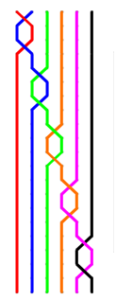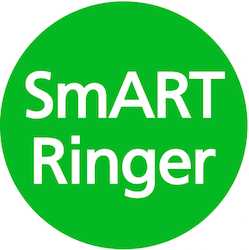Kaleidoscope ringing is a series of exercises made within two places. It can be started at handstroke or backstroke.
- These exercises are designed to help you listen to all the bells.
- They help you develop a sense of the place you are ringing in.
- They can be used on small numbers of bells perhaps early in the practice when there are only a few ringers present.
- It is easy for you to hear and identify your own bell striking as it moves in and out of rounds.
The simplest form is “long places” with four blows in one place. This is followed by “place making” with two blows being rung in each place and then by “dodging”. When these basic manoeuvres have been mastered they can be combined to form more advanced and complicated exercises.

Basic Kaleidoscope Works
Mexican Wave
A Mexican Wave is a simple form of Kaleidoscope ringing – sequential place making.

Mexican Wave
- It provides the first steps in learning to cover.
- It allows you to go into and out of the lead for two blows.
- It is a stepping stone from call changes to Plain Hunting.
- It helps to develop accurate striking.
- Two or three learners can ring at the same time.
- It can be rung for service.
- It provides an opportunity for very early calling.
- It is fun and makes more variety than just Call Changes.
Variations on a Mexican Wave
- Start at backstroke.
- Ring each place twice: “Echo Mexican Wave”.
- Put a dodge on either end of the places: “Dodgy Mexican Wave”.
- Set a second “wave” going before the first one has got to the back.
- Start from Queens.
Supporting Resources
Print off a worksheet of kaleidoscope works (*)
Acknowledgements
(*) CCCBR Education Committee
Central Council Publication: “Kaleidoscope Ringing – A Change Ringers Alternative to Call Changes” by Gordon Lucas
